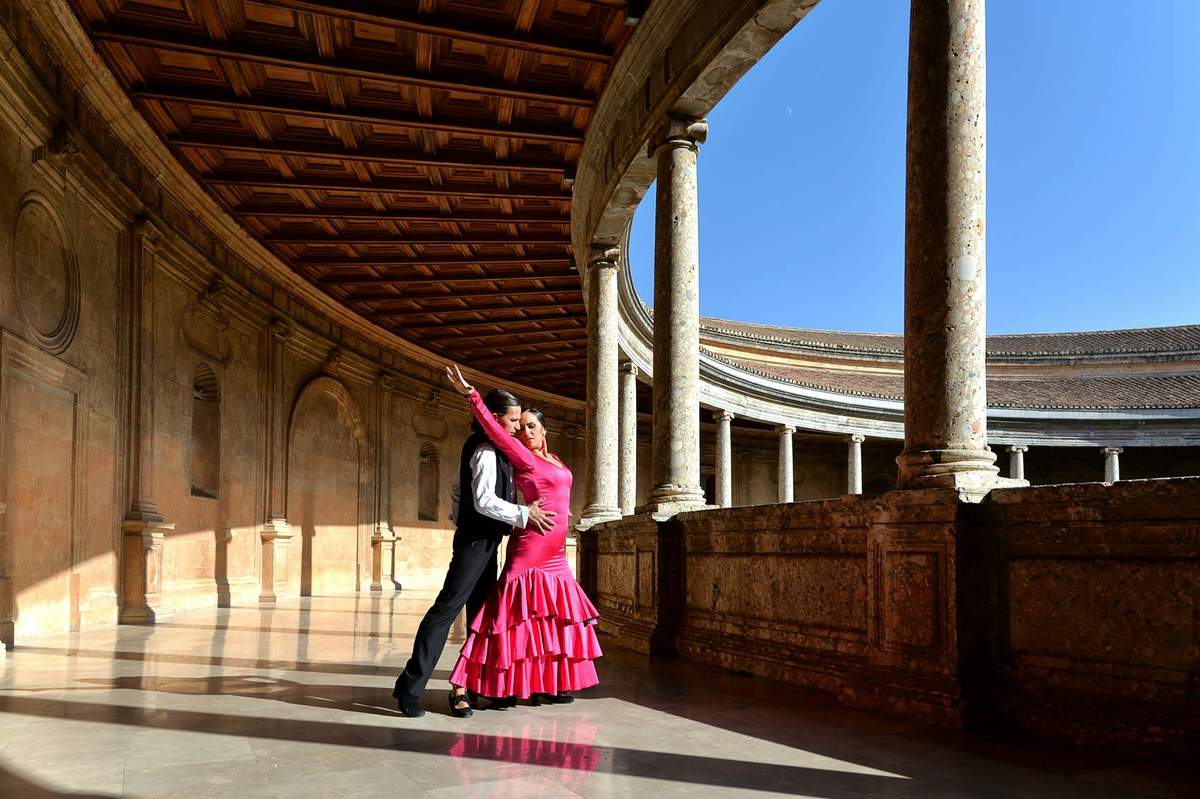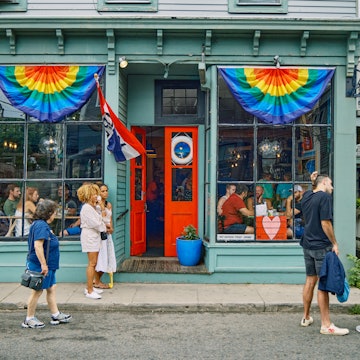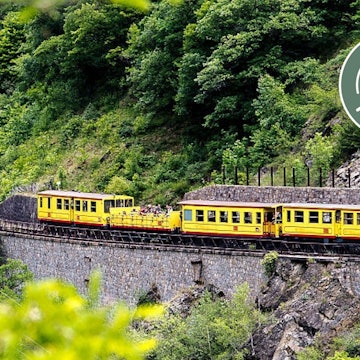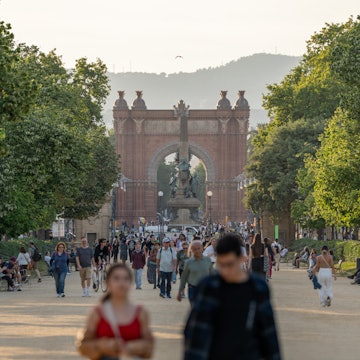

An evening scene along La Rambla during the Christmas season in Barcelona. Alexander Spatari/Getty Images
When December rolls around in Barcelona, lights start going up, market stalls start getting assembled – and someone goes about hiding a mischief-making figurine in the nativity scene.
Colorful displays bedeck historic center’s ancient alleys. And the Passeig de Grácia promenade transforms into a river of twinkling lights, leading pedestrians to the evening holiday light show projected on the mesmerizing facade of Gaudí’s Casa Batlló.
Christmas is a very special time indeed to be in Barcelona. For this is a city that never shies away from an opportunity to celebrate a holiday with flair, honoring tradition with a hefty dollop of spectacle on top. Read on for a few things to expect during Christmas season in Barcelona, plus tips for finding the best holiday markets and dishes.
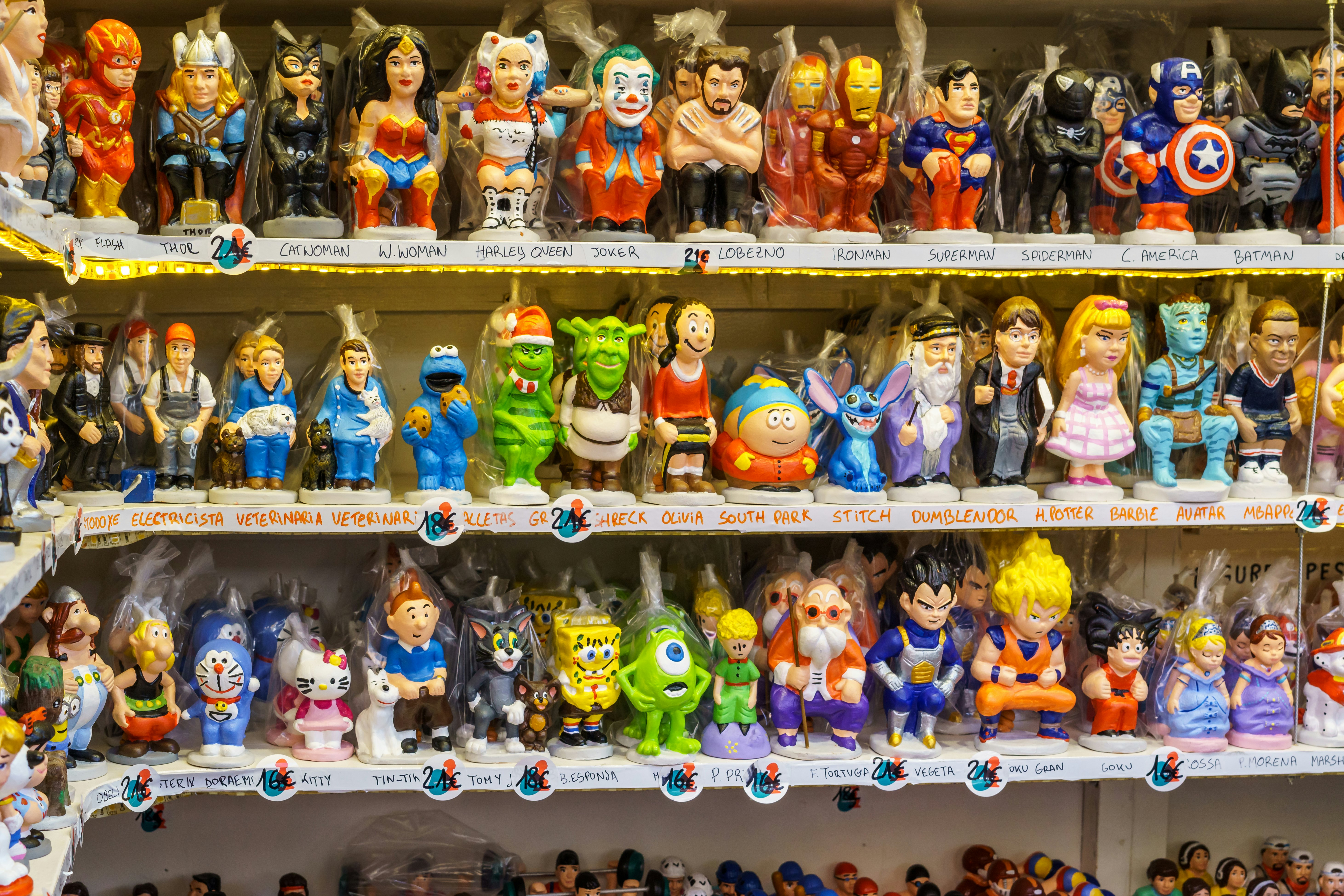
1. Keep an eye out for the “pooper” and friends
It’s safe to say that nobody has a Christmas tradition quite like the Catalans’ iconic caganer. While you’ll see the character on souvenir shelves throughout the year, Christmas is his time to shine.
The “pooper” (yes, that’s the literal translation of his name) is a traditional figurine that gets hidden in Catalan nativity scenes. While it might sound rather scandalous to Barcelona newcomers, the caganer is a beloved folk tradition among Catalans, who see his presence as a sign of good luck and even a symbol of fertility.
At Christmas markets, you will find caganers sold everywhere, alongside political and pop-culture figurines also striking a similarly...determined pose. From presidents and artists to Disney princesses and anime characters, the diversity will surprise you.

2. Santa isn’t the only gift giver in town
As you peruse Barcelona’s Christmas markets, you can’t miss the wide smile and bright red nose of one charming little piece of wood. The Tió de Nadal is the traditional Catalan Christmas log that gets placed under every tree.
In the run-up to December 25, children “feed” the log and cover it with a blanket to keep it warm. Christmas Day is the moment for Tió to keep up his end of the bargain and...poop out their presents. (Yes, even the logs poop in Barcelona.) There’s another twist: in order to get the presents, the children must hit the log with sticks and sing a song to help him produce the gifts. This happy little log is also called “Caga Tió,” meaning “Poo Log.”
3. Some local foods and flavors are only served during Christmas
From sweets to hearty winter dishes, there are a few different meals and treats gourmets can seek out on a Christmas trip to Barcelona. The easiest to pick up (you’ll also be able to buy any time of year) is torró, a traditional nougat bar made using honey and almonds that also comes in different flavors, and in both hard and soft nougat varieties. Head to one of the multiple locations of Vicens throughout the city and you might score a free sample.
For a filling hot dish, look for a traditional Catalan restaurant serving escudella, a soup with a light broth and large pasta shells stuffed with meat. Or try béchamel-covered canelones, another stuffed pasta dish that’s typically prepared on December 26, using the leftover meat from the Christmas meal the day before.

4. Barcelona Christmas festivities include markets and fairs
Christmas markets are a thing throughout Europe – and in Barcelona you can find them at the Fira de Nadal in front of La Sagrada Família in L’Eixample. In Barri Gòtic, Fira de Santa Llucia, in front of Catedral de Barcelona, has been an annual tradition since 1786. The majority of stalls sell traditional Christmas decorations and religious figurines, and there are usually some interesting finds in the mix where you can pick up ceramics or jewelry from local artisans.
After you’ve perused the stalls, make your way to Port Vell for the Fira de Nadal, which is set up every year on the waterfront. With food from local vendors, an ice skating rink, carousel and Ferris Wheel, as well as a few artisan stalls, there is plenty to entertain visitors of all ages.
You can also head to Montjuïc for even more fun at the Christmas Fair in Poble Espanyol, an open-air museum that brings together historic architectural styles from all over Spain in a functioning complex complete with bars and restaurants. In December, the “Spanish Village” gets into the spirit of the season with the Christmas Fair, a ticketed event with concerts and entertainment, such as circus performances and magic shows. The picturesque village looks absolutely magical dressed up in colorful lights; different themed areas reward exploration. Learn about the hidden histories of beloved holiday traditions in “Tradicionarius,” or visit Santa and the Three Wise Men in “Wishland.”

5. The festive season runs into the New Year
You might think New Year’s – ushered in with a glass of cava and 12 grapes at midnight – marks the end of Barcelona’s holiday season. But the party isn’t over until Three Kings Day on January 6.
The celebration starts the evening before with the Three Kings Parade, when the three kings disembark at the port following their long travels, receive a welcome from the mayor of Barcelona, then set off on a tour of the city. Families line the streets to watch the colorful floats pass by and to catch some of the sweets being thrown out to the crowds.
On the morning of Three Kings Day, you’ll notice long lines outside of Barcelona’s bakeries: locals waiting to pick up the Tortell de Reis, or King’s Cake, the tradition of the day. Sort of like a brioche with a marzipan filling, each cake is also baked with a small toy and bean hidden inside. Whoever finds the toy is proclaimed king for the day and gets to wear the paper crown. And whoever gets the bean? They have to pay for next year’s cake.






